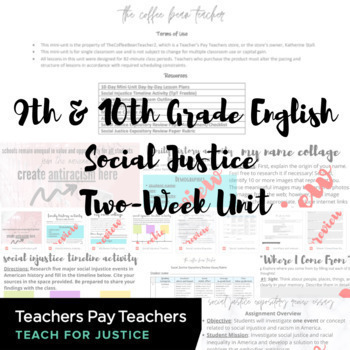9th & 10th Grade English Social Justice Two-Week Unit
- Google Drive™ folder

Description
Welcome! Thank you for your interest in my two-week social justice unit for ninth and tenth-grade English students. I created this unit based on the principles of antiracism and social justice. The unit aligns with Common Core State Standards for reading informational/literary texts and writing and Teaching Tolerance Social Justice Standards. I hope to share this affordable two-week unit that encourages students in ninth and tenth grade English to dive deeper into their origins to unearth personal biases. I believe the path to antiracism in our country begins in the classroom through exploratory and research-based units such as this one.
The unit provides in-person and online students the opportunity to join together for courageous conversations about racism in our country. With this unit's purchase, teachers receive an 11-page unit plan, including lesson sequences for ten class periods, suggestions and instructional best practices, and further suggestions for modification and differentiation. Those who purchase the unit will also receive access to an expository review paper summative assessment, a rubric for the essay, four handouts/activities for students, and original posters I created to display in the classroom.
Please double check all links when using this product. If one doesn't work for you, let me know! I'd be happy to send you an alternative link or adjust the product for you.
Lesson Topics:
- Day One: Who Do You Think You Are?
- Day Two: Who Do You Think You Are?
- Day Three: What Is Social Injustice?
- Day Four: History of Racism in America
- Day Five: The Civil Rights Movement
- Day Six: Desegregation In Schools
- Day Seven: Segregation In Schools Today
- Day Eight: Racism In Modern America
- Day Nine: Writing Workshop
- Day Ten: Writing Workshop
Texts Used Throughout Unit:
- "My Name" by Sandra Cisneros
- Children's Literature - teacher choice
- "I Have A Dream" by MLK, Jr.
- An assortment of texts from Teaching Tolerance - teacher choice
- "High School Training Ground," Malcolm London TedTalk
- "Wisdom from a Trailblazer: Ruby Bridges Talks Racism in Education"
- Excerpts from The Hate U Give by Angie Thomas





